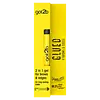What's inside
What's inside
 Benefits
Benefits

 Concerns
Concerns

 Ingredients Side-by-side
Ingredients Side-by-side

Water
Skin ConditioningPvp
Emulsion StabilisingAcrylates/Hydroxyesters Acrylates Copolymer
Acrylates/Steareth-20 Methacrylate Crosspolymer
Aminomethyl Propanol
BufferingPhenoxyethanol
PreservativePEG-40 Hydrogenated Castor Oil
EmulsifyingGlycerin
HumectantParfum
MaskingDMDM Hydantoin
PreservativePanthenol
Skin ConditioningSodium Benzoate
MaskingBenzotriazolyl Dodecyl P-Cresol
UV AbsorberEthylhexylglycerin
Skin ConditioningBenzyl Alcohol
PerfumingLimonene
PerfumingCI 60730
Cosmetic ColorantWater, Pvp, Acrylates/Hydroxyesters Acrylates Copolymer, Acrylates/Steareth-20 Methacrylate Crosspolymer, Aminomethyl Propanol, Phenoxyethanol, PEG-40 Hydrogenated Castor Oil, Glycerin, Parfum, DMDM Hydantoin, Panthenol, Sodium Benzoate, Benzotriazolyl Dodecyl P-Cresol, Ethylhexylglycerin, Benzyl Alcohol, Limonene, CI 60730
Water
Skin ConditioningAlcohol Denat.
AntimicrobialOctylacrylamide/Acrylates/Butylaminoethyl Methacrylate Copolymer
Acrylates/Stearyl Acrylate/Ethylamine Oxide Methacrylate Copolymer
Acrylates/Steareth-20 Methacrylate Copolymer
Water, Alcohol Denat., Octylacrylamide/Acrylates/Butylaminoethyl Methacrylate Copolymer, Acrylates/Stearyl Acrylate/Ethylamine Oxide Methacrylate Copolymer, Acrylates/Steareth-20 Methacrylate Copolymer, PEG-40 Hydrogenated Castor Oil, Aminomethyl Propanol, Panthenol, Gluconic Acid, Benzoic Acid, Caffeine
 Reviews
Reviews

Ingredients Explained
These ingredients are found in both products.
Ingredients higher up in an ingredient list are typically present in a larger amount.
Aminomethyl Propanol is used to adjust the pH of products. It is also used as a base to create other organic compounds. Having a balanced pH is important for protecting your skin.
Aminomethyl propanol is safe to use in cosmetics up to 1%. It is soluble in water.
Panthenol is a common ingredient that helps hydrate and soothe the skin. It is found naturally in our skin and hair.
There are two forms of panthenol: D and L.
D-panthenol is also known as dexpanthenol. Most cosmetics use dexpanthenol or a mixture of D and L-panthenol.
Panthenol is famous due to its ability to go deeper into the skin's layers. Using this ingredient has numerous pros (and no cons):
Like hyaluronic acid, panthenol is a humectant. Humectants are able to bind and hold large amounts of water to keep skin hydrated.
This ingredient works well for wound healing. It works by increasing tissue in the wound and helps close open wounds.
Once oxidized, panthenol converts to pantothenic acid. Panthothenic acid is found in all living cells.
This ingredient is also referred to as pro-vitamin B5.
Learn more about PanthenolPeg-40 Hydrogenated Castor Oil is derived from castor oil and polyethylene glycol (PEG). It is used as a emollient and emulsifier.
As an emulsifier, it helps prevent ingredients from separating. It also helps make the other ingredients more soluble; it is often used to solubilize fragrances. This increases spreadability and elongates shelf life in a product.
Emollients help soothe and soften the skin. They do this by creating a protective film on your skin. This barrier helps trap moisture and keeps your skin hydrated. Emollients may be effective at treating dry or itchy skin.
This ingredient may or may not be vegan, depending on the source.
Peg-40 Hydrogenated Castor Oil may not be fungal-acne safe. We recommend speaking with a professional if you have any questions or concerns.
Learn more about PEG-40 Hydrogenated Castor OilWater. It's the most common cosmetic ingredient of all. You'll usually see it at the top of ingredient lists, meaning that it makes up the largest part of the product.
So why is it so popular? Water most often acts as a solvent - this means that it helps dissolve other ingredients into the formulation.
You'll also recognize water as that liquid we all need to stay alive. If you see this, drink a glass of water. Stay hydrated!
Learn more about Water